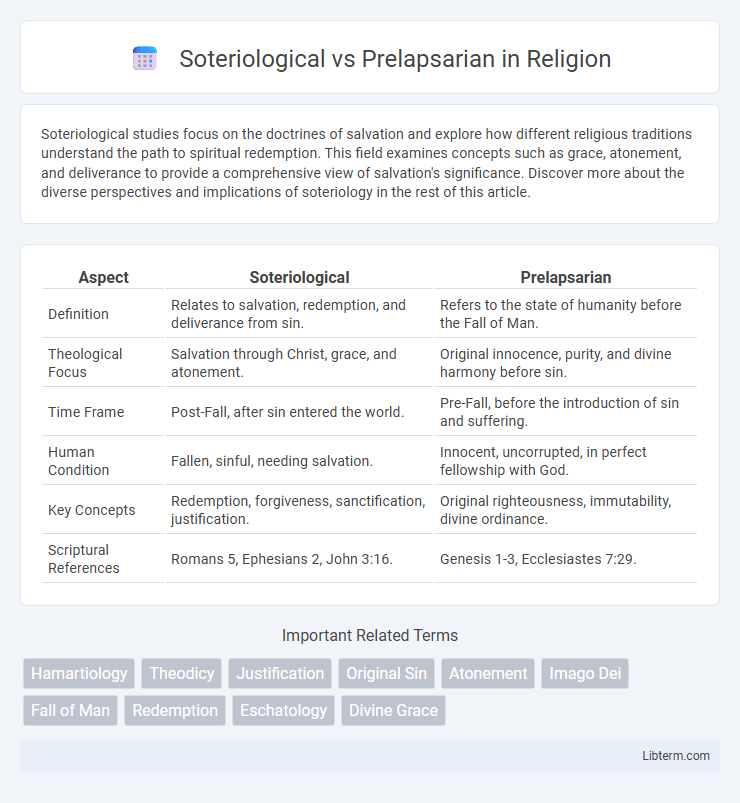Soteriological studies focus on the doctrines of salvation and explore how different religious traditions understand the path to spiritual redemption. This field examines concepts such as grace, atonement, and deliverance to provide a comprehensive view of salvation's significance. Discover more about the diverse perspectives and implications of soteriology in the rest of this article.
Table of Comparison
| Aspect | Soteriological | Prelapsarian |
|---|---|---|
| Definition | Relates to salvation, redemption, and deliverance from sin. | Refers to the state of humanity before the Fall of Man. |
| Theological Focus | Salvation through Christ, grace, and atonement. | Original innocence, purity, and divine harmony before sin. |
| Time Frame | Post-Fall, after sin entered the world. | Pre-Fall, before the introduction of sin and suffering. |
| Human Condition | Fallen, sinful, needing salvation. | Innocent, uncorrupted, in perfect fellowship with God. |
| Key Concepts | Redemption, forgiveness, sanctification, justification. | Original righteousness, immutability, divine ordinance. |
| Scriptural References | Romans 5, Ephesians 2, John 3:16. | Genesis 1-3, Ecclesiastes 7:29. |
Understanding Soteriology: Meaning and Significance
Soteriology, the study of salvation in Christian theology, explores the means by which humanity is redeemed from sin and restored to a right relationship with God. It contrasts with prelapsarian perspectives that consider human nature and divine intentions before the Fall of Adam and Eve, emphasizing the original state of innocence and perfection. Understanding soteriology involves analyzing doctrines of grace, atonement, and redemption, which are central to comprehending the transformative significance of salvation in theological discourse.
Prelapsarian Concepts: Life Before the Fall
Prelapsarian concepts depict life before the Fall as a state of original innocence, harmony, and perfection in the Garden of Eden, where humanity existed without sin, suffering, or death. This idealized condition emphasizes unspoiled human nature, free will exercised without corruption, and intimate fellowship with God, often contrasted with the post-Fall reality marked by spiritual and physical decay. Understanding Prelapsarian theology provides critical insights into doctrines of original righteousness and the inherent potential for redemption within soteriology.
Soteriological Perspectives in Christian Theology
Soteriological perspectives in Christian theology primarily emphasize the doctrine of salvation through Jesus Christ, highlighting themes of redemption, atonement, and grace as central to human reconciliation with God. This framework explores how sin, humanity's fallen state, and divine intervention interplay to restore spiritual wholeness, often contrasting with the Prelapsarian ideal of innocence before the Fall of Adam and Eve. Key soteriological models include substitutionary atonement, Christus Victor, and moral influence theories, each interpreting the salvific work of Christ in nuanced ways to address human redemption and restoration.
Prelapsarian State: Key Characteristics
The prelapsarian state refers to the condition of humanity before the Fall in Christian theology, characterized by original innocence, purity, and harmony with God. This state is marked by the absence of sin, perfect knowledge, and an intimate relationship with the Creator, symbolizing ideal human existence. Prelapsarian conditions emphasize unbroken fellowship, moral integrity, and the absence of suffering or death, contrasting sharply with the corrupted postlapsarian world.
Core Differences: Soteriological vs Prelapsarian Views
Soteriological views concentrate on the study of salvation, emphasizing human redemption and the role of divine grace through Christ, while Prelapsarian views focus on the state of humanity before the Fall of Adam and Eve, highlighting original innocence and untainted divine favor. The core difference lies in their temporal and theological focus: Soteriology addresses post-Fall conditions and the mechanisms of salvation, whereas Prelapsarian theology examines the perfect, sinless existence prior to the Fall. These distinctions shape differing interpretations of human nature, grace, and divine intention within Christian doctrine.
Redemption and Salvation: The Soteriological Approach
The soteriological approach centers on redemption and salvation as key themes in theological discourse, emphasizing humanity's deliverance from sin through divine intervention. This perspective highlights Christ's sacrificial role and the transformative power of grace as essential for restoring the broken relationship between God and humanity. In contrast to the prelapsarian view, which idealizes the state before the Fall, soteriology focuses on the process of salvation that follows humanity's fall into sin.
Human Nature: Prelapsarian Innocence versus Fallen State
Prelapsarian human nature represents the original, untainted innocence characterized by harmony, purity, and moral perfection prior to the Fall, reflecting an ideal state of existence in theological anthropology. Soteriological perspectives emphasize the fallen state, highlighting human nature's corruption, guilt, and alienation from God due to original sin, necessitating divine redemption through grace. Understanding this contrast between prelapsarian innocence and postlapsarian fallenness is crucial for comprehending doctrines of salvation and human moral potential.
Doctrinal Implications for Faith and Practice
Soteriological doctrines emphasize salvation achieved through Christ's redemptive work, shaping faith by highlighting grace, repentance, and sanctification as central to Christian life. Prelapsarian views, centered on humanity's state before the Fall, influence beliefs about original righteousness, free will, and the innate human condition, thus affecting moral responsibility and spiritual accountability. Understanding these theological perspectives informs doctrinal teaching, worship practices, and ethical behavior within various Christian traditions.
Theological Debates: Relevance in Modern Christianity
Theological debates surrounding Soteriological and Prelapsarian concepts remain highly relevant in modern Christianity, influencing doctrines of salvation and human nature. Soteriology focuses on the study of salvation through Christ, while Prelapsarian theology refers to humanity's state before the Fall, shaping interpretations of original sin and grace. These discussions impact contemporary Christian views on redemption, free will, and divine justice, underscoring ongoing efforts to reconcile scriptural teachings with evolving theological perspectives.
Integrating Soteriology and Prelapsarianism in Contemporary Discourse
Integrating soteriology and prelapsarianism in contemporary discourse involves analyzing salvation doctrines alongside the state of humanity before the Fall, highlighting how original innocence shapes redemption narratives. This approach deepens theological understanding by tracing humanity's pre-Fall nature to the necessity and scope of Christ's salvific work. Contemporary scholars utilize this integration to explore contrasts between idealized prelapsarian conditions and postlapsarian realities, enriching debates on grace, sin, and divine purpose.
Soteriological Infographic

 libterm.com
libterm.com